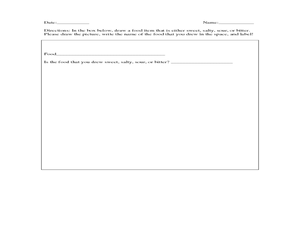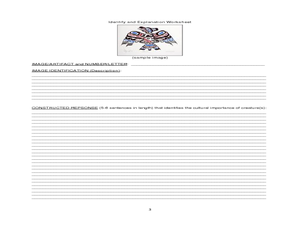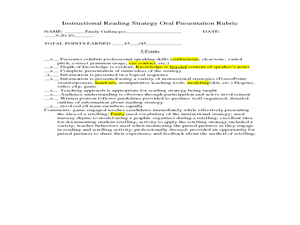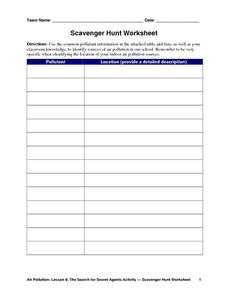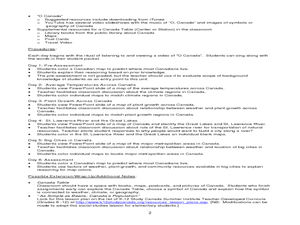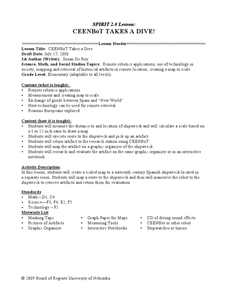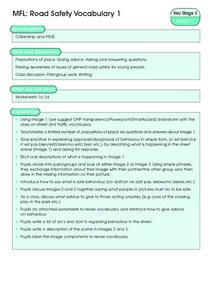Curated OER
Aquatic Roots
Young scientist use reference materials to research various local aquatic plants and or animals to find out whether they are natives or exotics. They investigate their impacts on people, other animals and the environment. High schoolers...
Curated OER
Biography Chat
Learners profile a mock television talk-show format to conduct mock interviews with famous people in history. Students read biographies of famous people in history. Learners assemble questions for interviews.
Curated OER
Terrific Taste Buds
Young scholars explore descriptive writing by eating food in class. In this descriptive word lesson, students assess different foods in class such as jelly beans and utilize their vocabulary to describe the taste. Young scholars read the...
Curated OER
How Are Stars Like People?
A beautifully written lesson plan delves into a beautiful topic: stellar population. Engage aspiring astronomers with activities that examine human populations and then transition onto the stars of the universe. Data and photographs for...
Curated OER
Stories Behind Pacific Northwest First Nations' Images
Students investigate Canadian culture by examining mascots of the 2010 Olympics. In this Canadian history instructional activity, students read a Vancouver Olympics guide to identify three Canadian mascots and their importance to...
Curated OER
What Do You Call Older People?
Pupils brainstorm a list of words they use to refer to the elderly. As a class, they discuss the importance of word connotations and explain those used to refer to the older population. They complete a handout and share their thoughts...
Curated OER
Word Books
Students explore art and writing. They create a word book consisting of new words that they come across in their reading or words they hear from people. Students create a cover for their word books.
Balanced Assessment
The Triskaidecaphobia Conference
Triskaidecaphobia is an extreme superstition to the number 13—and ironically the answer to the word problem is 13! Presented with a series of descriptive data, individuals analyze the data to determine the population size. They...
Curated OER
Move It!!!
Students explore motion by observing the movement of people and duplicating those movements. They compare and contrast various kinds of movements and identify different types of movements in pictures. They build an object that can be...
Curated OER
Lesson Plan 18: Art Project! Design Your Own Book Cover
Finished your novel? What’s next? Designing the book cover, of course. But how to begin? After examining the covers of published books and noting the common elements of these jackets, young novelists design a front and back cover for...
Curated OER
Newcomers
Explore emotions associated with moving to a new home with young learners. First they listen to the books Painted Words/Spoken Memories by Aliki and Going Home by Eve Bunting. Then they are invited to share their experiences as well as...
Curated OER
Retelling
Explore language arts by completing a story worksheet in class. Readers will identify the importance of plot, setting, and character while they write their own short story. They also retell their story to a classmate and participate in a...
University of Kentucky
The Great Spider Debate
Poor, misunderstood spiders! They are feared, disrespected, and detested by many people, yet they do so many positive things. A great addition to any insect unit, learn about some of the more common spiders, while hopefully dispelling...
Curated OER
Cathlapolte.... Catching Time's Secrets
Third graders investigate nature by studying a Chinook village from the past. In this sustainable living lesson, 3rd graders examine the architecture, environment and activities of the Chinook people. Students create a...
Curated OER
Using Our Five Senses
Pupils explore human anatomy by creating an oral report in class. For this five senses lesson, students read several real life situations and identify which of the five senses help in certain situations. Pupils create an oral...
Curated OER
Plant Parts We Eat
I bet the kids in your class will love to eat their vegetables after an engaging lesson about edible plants. They read information about vegetables and edible plants, sort vocabulary words, identify plant parts, measure and graph the...
Curated OER
Food Pyramid
Third graders examine healthy eating habits by identifying the food pyramid. In this personal health activity, 3rd graders discuss their own eating habits and how there should be a variety of foods in all diets. Students...
Curated OER
Scavenger Hunt Worksheet
Exactly how environmentally friendly is your school? From the air fresheners in the bathrooms to the cleaning solvents used in the classrooms, young conservationists search the school grounds for sources of air pollution in...
Curated OER
Where Do Canadians Live?
Students investigate Canadian people by researching the geography of the country. In this world geography lesson, students identify locations within Canada with large populations based on their access to waterways. Students...
Curated OER
Minerals and Rocks
Students identify and interpret various minerals and discover how to identify and classify them. They identify and discuss how people describe objects and how scientists describe objects. From there, students look at a set of common...
Curated OER
Twenty Green Gates
Second graders explore mathematics by participating in a pattern building activity. In this geometric construction lesson, 2nd graders discuss a story problem in which a gate needs to be built from triangles and trapezoids up to a...
Curated OER
CEENBoT Takes a Dive
Learners create a map to scale using technology. In this algebra lesson, students navigate through a shipwreck to perform rescues. They use he CEENBoT program to perform the different tasks.
Curated OER
Litter Recognition
Students identify litter, and discuss what to do with it. They analyze people's response to litter. Some people may ignore it, while others may pick it up. They observe student behavior as part of an experiment.
Curated OER
MFL: Road Safety Vocabulary 1
Students brainstorm any words they associate with traffic and safety. In groups, they work together to complete a worksheet identifying images. They also discuss what they would tell someone who was acting unsafely.


